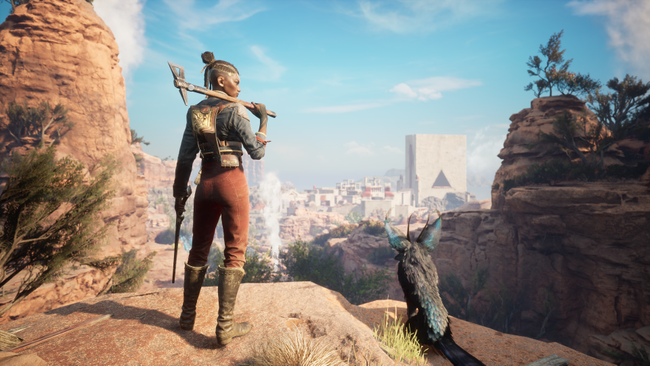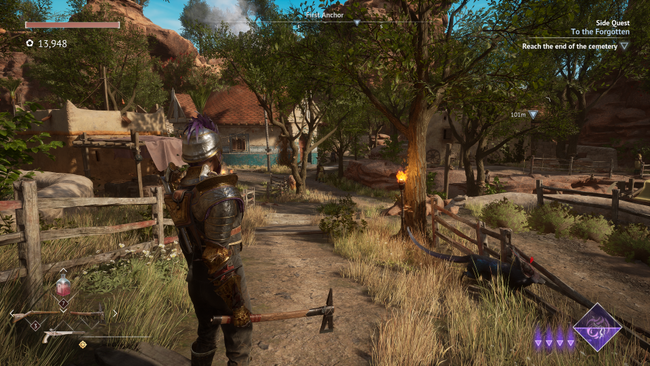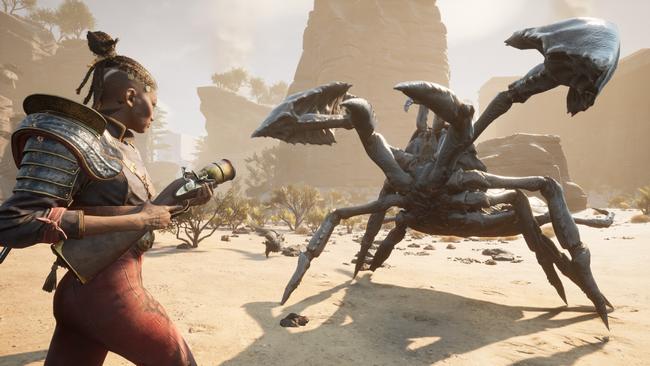
Flintlock: The Siege of Dawn Review
One topic that often arises when discussing souls-like action RPGs is their difficulty, which is usually followed by discussions on accessibility needs and how that relates to game design, identity, and overall philosophy. We saw it very recently with the release of Shadow of the Erdtree, in which our own review briefly outlines how the expansion adds new wrinkles in the challenges offered compared to the Elden Ring base game. A considerable level of challenge has more-or-less become expected in games that share the general souls-like formula, and there is no shortage of opinions on how this can or should take shape.
One reason why I am opening this review with the topic of challenge and accessibility is because the development team at A44 Games did so when introducing Flintlock: The Siege of Dawn to reviewers, like me. "When we set out to make Flintlock, we were keen to make a new, more approachable, and accessible variation on the Souls genre," is how creative leads at the studio phrased it. A44 wanted to make Flintlock an "entry point" into the genre, with various components made to appeal to players who aren't typically fans of souls-like games, or those who have never played one.

Flintlock follows Nor Vanek, a Coalition mercenary-type warrior who fights against both the living dead and the Gods who have broken out of "The Great Below" into the real living world. Alongside Nor is a feathered fox-like familiar named Enki, who assists Nor in her fight while offering a unique insight into the gods and their realm.
When you start the game, you can choose between three difficulty levels — Story, Normal, and Possessed — and you can switch between these modes at any time during gameplay. The Normal level will not offer much challenge to those already familiar with souls-like games, true to the message A44 laid out in making an approachable entry in this space. The Story difficulty lightens things up even moreso and even comes with an option to give Nor infinite health for those who truly want to experience the narrative of Flintlock without hurdles, with the only tradeoff being an inability to earn achievements in this mode. While I did not spend a lot of time with it, the Possessed difficulty will offer an experience that may feel more familiar to veterans of the genre.
Is Flintlock: The Siege of Dawn a soulslike? Well, the developer describes it as such explicitly, for starters. It is the second game from the studio at A44 games, following 2018's Ashen, which also exhibited a stated influence from A44's love of the Souls games. Unforuntately, I have not played Ashen, so I can't make any comparisons between the two titles directly.

Flintlock shares many components common to the subgenre, such as an experience/currency equivalent, called Reputation, which is collected from defeating enemies and can be spent on skill trees to give Nor more abilities or passive bonuses. Reputation can also be spent at shops for new equipment or costumes. Enemies respawn by resting at a campfire, and you have the opportunity to recapture lost Reputation, should you make your way back to whichever foe felled you in battle moments before. This should all sound familiar to genre veterans.
One of Flintlock's most unique twists on these common fundamentals is a multiplier system that can boost the amount of Reputation you earn. By varying up the types of combos and weapons used as you fight enemies, a multiplier is added to whatever the base amount of Reputation gained from defeating foes. For example, if you parry an enemy's attack, dodge, shoot them with a pistol, and then defeat them with an axe combo, you'll gain a higher Reputation multiplier than if you just stuck with the axe combo only.
Once your multiplier is high, you can then choose to 'redeem' the Reputation you've earned, using that multiplier bonus as it resets for the next round of Reputation. This multiplier system is an incentive to use all the tools in your arsenal and to vary up your combat approach when you can. However, if you take a hit, your multiplier is set back to 1, so this system also rewards those skillful or careful enough to avoid taking damage. Overall, I think this addition is a successful one.
Unlike Souls games, Nor does not really have a numerical level or inherent stats that can be upgraded at will. Instead, most of the game's numbers come from the equipment you buy and upgrade with materials. Also unlike most contemporary games, there is no real stamina meter, so you can attack at will as long as you are sure you will hit your target. This leads Flintlock to having a faster pace, since you don't have to worry about letting stamina refill between bouts of attacks.

The component of Flintlock that I would say is most successful is that melee combat feels good to play. The animations, camera movement, and sound effects when your axe lands on a target are satisfying and sensible. The 'weightiness' feels proper and the controls are responsive. Parrying is also a significant component of the combat, and luckily, the successful parry window feels generous. You'll also be able to fire off your flintlock pistol in between melee attacks, which is sometimes incredibly useful for knocking an enemy off-guard just before hitting them with a deadly axe combo.
In addition to Nor's movement and abilities, you also have some control over Enki, your fox-like familiar. While Enki doesn't really do damage himself, he can apply various 'curses' to enemies, such as diminished armor value, diminished attack power, or a poison HP drain. Also, applying curses can fill a separate 'break' meter of sorts, which once full, allows Nor to initiate a critical hit. This is a slightly more cinematic animated attack that either does a significant portion of damage, or can remove armor from armored enemies.
Although the combat itself feels good, I still found myself slightly disappointed with the game's enemy variety, as well as the game's overall world traversal structure. I wouldn't say either of these components is outright poor, more just plainly adequate without excelling in any particular way. Many of the the enemies you face are humanoid, and while their armaments may differ, are generally approached and defeated in battle all in the same way. Even several of the game's 'mini-boss' battles are mostly normal humanoid enemies, only with an inflated HP pool. While there are some monstrous enemies, such as giant scorpions and big spiders (those with phobias, be warned), these are relatively rare in comparison. Enemy behavior is a little bit predictable and stiff too. It's a little bit amusing when you can 'snipe' a baddie from far away, and his baddie partner standing three feet away doesn't seem to care that his friend was just shot in the head.
Flintlock is not 'open-world' and is mostly divided into two separate zones. These zones are navigated through mostly linearly, with a few side branches here and there. You'll actually do a significant amount of exploring through a sort of portal-jumping mechanic, via Enki. Probably the easiest way to visualize this is that there are magic 'slingshot' points dotted throughout the world that can boost Nor up cliffside or over canyons, and you can unlock more of these as shortcuts over time to make area revisits a little bit simpler. The second zone especially is a bit denser than the first, offering a bit more verticality. Sometimes the focus on verticality can be a little bit frustrating ("How do I get to that platform up there?") but I still prefer it to more linearly guided traversal of the first zone.
There are sidequests to take on in addition to the main questline, but for the most part, these felt pretty standard and forgettable to me. There is one slightly more notable sidequest that takes you to a separate zone of the map that stands above the rest, but otherwise, there's little to latch onto here. I can barely muster up much to describe here in text, which I suppose is indicative of what sort of lasting impression these quests may have.

There's one design component to Flintlock that is genuinely confusing to me, so much so that I wonder if I am fundamentally misunderstanding it. One of the primary ways to improve your combat capabilities is to spend material resources collected in the world to upgrade Nor's weapons and accessories — things like her axe and pistol. However, these resources you can find are finite, and thus cannot be 'farmed' indefinitely. You only get so much wood and stone that you can spend on these upgrades, which means how you decide to spend those limited materials becomes an important choice to make. I assume limiting resources in this manner was done as an incentive to explore and make finding a loot-able wood pile feel valuable.
Especially when it comes to some of the later upgrades in the game, the cost of improving weapons becomes considerably expensive. You'll pick up multiple axes and multiple pistols throughout Flintlock, each with different inherent combat properties. You ultimately have to pick and choose which axe or pistol to spend your finite resources on, because you will not have the materials to spend on more than one. If you spend materials on a weapon you ultimately don't end up using or caring for, it's essentially a waste of materials that you won't be able to recoup. The game even suggests, if you are struggling, to try out new equipment with different properties in the game's tip menus, but this design seems to discourage it outright. Functionally, you have to pick a weapon and stick with it, and hopefully you have the foresight to know what works best for you before you try it. I feel like there should be a way to spend Reputation on materials, even if the price comes at a premium.
Despite spending two paragraphs on this material design component, I don't think it's a deal-breaking flaw, because the game itself is not challenging enough or long enough for this to truly detract much in the overall scheme of the game. That said, it is still a somewhat baffling design choice to me, and one that could possibly be alleviated in an update or patch, should the developer choose to do so.

The environments in Flintlock look good, ranging from forested woodlands to arid deserts, muddy swamps, and pre-industrial cities. However, character models and facial animations never quite felt right, to me, unfortunately falling into that uncanny valley where characters almost appear photorealistic but always appear just a little 'off'.
I've avoided talking about the game's story for most of this review because, honestly, I feel like there's not much to say. Besides some parts of the opening, most of the narrative is delivered via conversations between Nor and Enki, rather than shown to the player in any capacity. Typical to the genre, bits of world lore can also be found in various key items found throughout the world.
In the end, though try as I might, I could not bring myself to care much about Nor's situation, Enki's predicament, or the stakes that the game ultimately builds to. It's sometimes difficult to ascertain why exactly a narrative doesn't quite hook right, but I suppose in this case, I felt that the narrative on display was too disparate from the gameplay experience itself. Without spoiling anything outright, Enki is placed in the narrative often like an exposition mouthpiece, mostly explaining to Nor what is happening in the world around them over the course of the game. It just never quite felt organic to me, and sometimes even felt a little contrived simply to give Nor enemies to fight.
Flintlock feels like it would be an ideal rental game. It's relatively short with a runtime about 15-20 hours long, or even less if you stick primarily to the main questline. Perhaps it's appropriate to be releasing on Xbox Game Pass at launch, where subscribers and genre-newcomers can safely see what Flintlock has to offer without fear of buyer's remorse. It's also worth noting that Flintlock is not a full-priced release, with the game's standard retail price landing at around $40.
Flintlock: The Siege of Dawn is an approachable action RPG with satisfying combat but a narrative that unfortunately left little impression on me. While combat itself is enjoyable, battle variety is somewhat lacking, quests feel typical, and the narrative is forgettable.